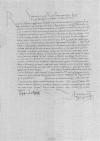List #1866
Sigismund I Jagiellon do Ioannes DANTISCUS & Janusz LATALSKICracow (Kraków), 1538-06-12
| odebrano [1538]-06-14 Rękopiśmienne podstawy źródłowe:
| ||||||||||
Tekst + aparat krytyczny + komentarz Zwykły tekst Tekst + komentarz Tekst + aparat krytyczny
Reverendo in Christo Patri
Reverende in Christo Pater et Magnifice, sincere nobis dilecti.
Cum scribi inter alia iuberemus in ea, quam
S(trenuitatibus) or S(inceritatibus)⌈S(trenuitatibus)S(trenuitatibus) or S(inceritatibus)⌉ Vestris misimus instructione, si ita visum esset serenissimo domino
Ceterum quod scribunt S(trenuita)tes or S(inceritatrenuita)tes⌈S(trenuita)tesS(trenuita)tes or S(inceritatrenuita)tes⌉ Vestrae olfecisse se nonnihil per nuntios serenissimam
Qua de re S(trenuitati)bus or S(inceritati)bus⌈S(trenuitati)busS(trenuitati)bus or S(inceritati)bus⌉ Vestris iterum mandata damus, ut illis tanto sit curae maiori atque ut qua ratione tractanda sit ea res, certius possint cognoscere, mittimus illis quaedam de hac ipsa causa scripta in comitiis Wratislaviensibus, ex quibus qua via sit negotium aggrediendum, facilius intelligent.
Abbas Mogilnensis vendidit quandam villam, quam in
Facient autem nos strictim breviterque S(trenuitates) or S(inceritates)⌈S(trenuitates)S(trenuitates) or S(inceritates)⌉ Vestrae certiores per cubicularium hunc nostrum, si quid actum iam per illas fuerit. Fussius autem et subtilius nobis omnia narrabunt, ubi rebus, ut speramus et optamus, ex sententia nostra confectis ad nos incolumes erunt reversae. Id quod S(trenuitatibus) or S(inceritatibus)⌈S(trenuitatibus)S(trenuitatibus) or S(inceritatibus)⌉ Vestris ex animo precamur.
Dat(ae) or Dat(um)⌈Dat(ae)Dat(ae) or Dat(um)⌉
Ad mandatum s(acrae) or s(erenisimae)⌈s(acrae)s(acrae) or s(erenisimae)⌉ maiestatis regiae proprium


 BNW, BOZ 953, f. 168v.
BNW, BOZ 953, f. 168v.